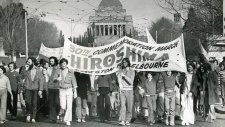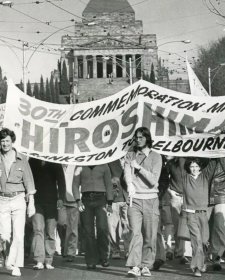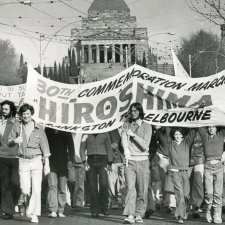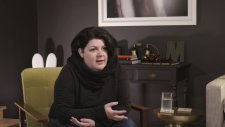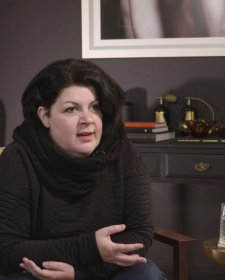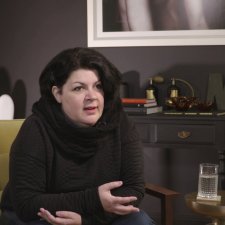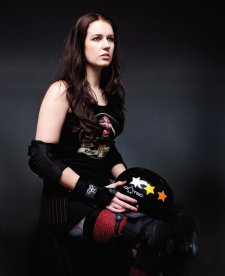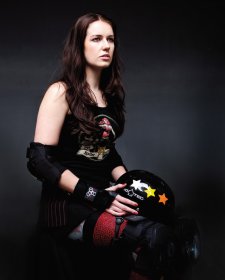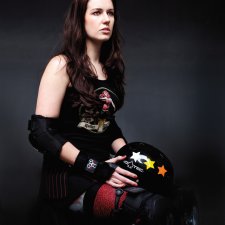- So without further ado, I'd like to introduce our special guest, who is a long time friend of the National Portrait Gallery here in Canberra, Nikki Toole. Hello, thank you so much for joining us, Nikki.
- How you doin?
- Thank you, especially for agreeing to programme, which is at lunchtime in Canberra Australia, but is at the very unfortunate time of 2:30 AM in Paris.
- I've had a few coffees, I'm fine, I'll be okay.
- Nikki, we have some amazing portraits of yours in the collection, in the National Portrait Gallery Collection, but you also have had quite a few portraits come through our National Photographic Portrait prize. Shall we start having a little look at some of the works or some of your incredible portraits from across the course of your career? I would love to start with one of my favourite portraits in the National Portrait Gallery Collection. And that is this, I'm hoping everybody at home can see this one now, that's this incredible portrait of Tilman Ruff. Would you mind telling us a little bit about this portrait, Nikki?
- The lovely Tilman. I was contacted through Icon to photograph a portrait of Tilman, they asked me if I would be interested in doing it. And of course, I was very flattered to be asked, so I agreed. And I spoke to Tilman briefly beforehand, and he came to my house, he's a Nobel Peace Prize Laureate. And he brought his Nobel Peace Prize with him, which I was very excited about 'cause I'd always wanted to see one, but all of the pictures I've seen of Tilman, he always had his glasses and a suit on, always looked very, you know, official. So we talked for quite a bit and he told me about how he'd go hiking in the Dolomite Mountains in Italy, how he'd spend time on the farm with his family. And I was really intrigued by that aspect of his work. And I know that he works with the Australian Red Cross in many countries. You know, he works with children and helps towards developing vaccines, and with Hepatitis B, and other things. So I said to him, can you bring a few things just from home that you'd be comfortable? And, and when he got to my house, he's actually just sitting at my kitchen table in Australia in this portrait. He pulled out this red sweater that had holes in it and I just thought it was great.
- [Gil] I would love to start with one of my favourite portraits in the National Portrait Gallery Collection. And that is this, I'm hoping everybody at home can see this one now, that's this incredible portrait of Tilman Ruff. Would you mind telling us a little bit about this portrait, Nikki?
- The lovely Tilman. I was contacted through Icon to photograph a portrait of Tilman, they asked me if I would be interested in doing it. And of course, I was very flattered to be asked, so I agreed. And I spoke to Tilman briefly beforehand, and he came to my house, he's a Nobel Peace Prize Laureate. And he brought his Nobel Peace Prize with him, which I was very excited about 'cause I'd always wanted to see one, but all of the pictures I've seen of Tilman, he always had his glasses and a suit on, always looked very, you know, official. So we talked for quite a bit and he told me about how he'd go hiking in the Dolomite Mountains in Italy, how he'd spend time on the farm with his family. And I was really intrigued by that aspect of his work. And I know that he works with the Australian Red Cross in many countries. You know, he works with children and helps towards developing vaccines, and with Hepatitis B, and other things. So I said to him, can you bring a few things just from home that you'd be comfortable? And, and when he got to my house, he's actually just sitting at my kitchen table in Australia in this portrait. He pulled out this red sweater that had holes in it and I just thought it was great. And I was like, that's what I'm thinking of. That's gonna be awesome. And he was also very comfortable in it. So I want people to be as comfortable as possible because I don't take a lot of shots. Sometimes I'll just do it on five or six of each person. So they need to feel relaxed very quickly. And it was great, we just talked, we talked about his German heritage and the traditions that they do at Christmas. And it kind of reminded me of him, Edmund Hillary, you know, the Explorer. And I felt that kind of stoic look about him, I kind of loved it and that's what I saw in Tilman. And I tried to kind of capture that essence in the photograph.
- I think you've done a brilliant job. I was lucky enough to meet Tilman as well, when he came to record a portrait story interview with us at the portrait gallery and Matt, who's running our chat today might be able to pop a link to that interview in the chat here and on Facebook. So everyone can have a look because he really is one of the most delightful human beings you could hope to meet, so generous. And so, you know, generous with his time and just the incredible work that he does.
- Yeah. It's incredible what he'd achieved. It's a huge achievement and I can see they were so well deserving, the whole of Icon, really of the Nobel Peace Prize, but he's very, just very sweet and really incredible human being first before anything else. Just the loveliest, one of the loveliest people I've ever met. So it was just such an honour to photograph Tilman.
- Interestingly, I was having a look through this presentation last night, Nikki, and it's not that often that you photograph people looking off into the distance, a lot of your series, which we'll go delve into shortly, a very kind of, even if their body is angled, the gaze is very frontal. So is that something unusual for this particular portrait that, or is it just something that you get the right moment and you just know it's the right moment?
- It was just the right moment. I think we were talking and the window is actually facing Tilman. So it's just that'll always use natural daylight if I can. And I just loved the way the light was, and there was something about the wedding ring facing the family one way, and the kind of looking over, is it's like he has a dual life in a way because he has the work he does, which must be incredibly time-consuming. And then he has this other life on the farm, which is also incredibly important to him. So I kind of liked the way that he was looking off almost like an Explorer, kind of enter the distance. You know, you see these images from the 1930s and things. So that was just the way I saw him because I saw a picture of him on the Dolomite Mountain's wearing an old sweater. I thought, Oh, that's the Tilman that I'm talking to. So I was just trying to capture that instead of the way, I sometimes like to try and capture people in a slightly different way than everyone usually sees them. So I think with this, I was quite happy with it in the end, because it was a little bit different from the more official images that you see of many shot in tie and everything.
- And a few years ago now you had an exhibition at the National Portrait Gallery called "Skater." And I'd love to have a look at a few of those images for that exhibition now. And from that book, actually in that series, would you mind having talking us through the concept for this series? And we'll have a look at some of the portraits as we go through.
- Yeah. With Skater, I tend to a lot more work 'cause a thread running through it that's something that I'm actually very familiar with or something that comes from my youth or my childhood. And when I was young, I used to skate quite a bit. And I was really intrigued by the way that when you skate, you go into another headspace. So I compare it to people who know how to play the piano, after a while it becomes instinctive. If you think about the notes you're playing, you make a mistake. And when I talk to skaters, they all say the same. And one of the skaters Luke Brown who's actually, he's from Canberra, he's on the cover of the book. He told me it was like a zen moment. So when you skate, you go into like a zen headspace. So when I talked to the skaters, I said, you know, can you just stand? And can you imagine yourself in the headspace that you would be in? And it's interesting how similar they all looked in the end, when they all did this kind of hexed this look to me. So we travelled the world as much as we could for three years off and on, obviously, 'cause we have to work in between. And every country I'd go to, I didn't want it to show, you know, a landmark like, Paris be, the Eiffel Tower or something like that. I want it to show the skate parts or a street they would be skating in. So it was kind of, you were focused on the skater and not so much on where they were, or the labels that they're wearing. So almost becomes like a partum when you look at them all together 'cause there's 300 of them. So it's just these drove quite similar, they're quite different at the same time.
- [Gil] Yeah, they're brilliant, aren't they? And I was really struck when I was looking through the series again, just how many girls and women featured.
- It's a really big thing. I think, it was funny when I came to Portugal and I did a talk with Chris at the time, and we talked about skating in different places where I have to shoot the project. I think quite a few people said to me afterwards, they didn't realise what positive experiences for a child to be able to skate because it gives them so much confidence. I mean, as one of the best forms of exercise that can really do, it doesn't cost much. They can skate almost anywhere and it brings them into a group that's a real comradery between young and old skaters alike. I think it's one of the best sports for young people that there is, because it appeals to people from all levels of the economic, you know, sort of you're haven't got much money, you can still usually find a secondhand skateboard or whatever, and you can have just as much fun. And there's just something really incredible about seeing young people gain a lot of confidence in themselves through skating. So I think it's underestimated of how important it really is within. We focus on other sports a lot, you know, like AFL and everything else, but skating is a very, very important to a child's wellbeing when they start learning how to do it.
- Yeah. Yeah, absolutely.
- Sorry.
- No, please.
- It's fine.
- Speaking of confidence, the next series that we're gonna do pin to you, you can't beat the confidence in these women. In fact, a lot of people do try to beat the confidence out of these women
- These women are really incredible.
- But we're talking about Roller Derby Girls.
- The Roller of Darby are amazing. I mean, I actually met a couple of them while shooting the skater project and had an idea for awhile. When I was young in Scotland, I would go to lots of places where there were always, you know, portraits of military portraits on the wall, military paintings from 19th century. And I loved it, they were just, it was this idea of the person and the painting who was in full military dress ready to go to battle was not the same person by any means who would actually be in battle. There were two very different representations of that person and their persona. And I loved these girls, you know, for example, Mel Andy is a librarian in a school, I'm not sure what else she does, but she's kinda an amazing person, she's the lucky day one. And so many of them were midwives or, you know, lawyers, teachers, they were all different professions. And then they all came together, which into quite a brutal sport. I mean, if you've ever seen a Roller Darby match, they don't take any prisoners. They're constantly covered in cuts and bruises because you have to basically knock the other person down at a high speed to win the game for your team. So they were just incredible. So I loved that they were wearing this armour and they all had these very different personalities. You know, they give themselves a name. So for example, and red stripes is Bambi Thumper, her name is, and she's our '50s persona, they all have these different personas and I just loved it. Cardi Deville is the girl next to her. And it was just great, they really invested in it. I love subcultures, I love these little subcultures where people really express themselves. It gives them confidence, they feel part of something. I think the idea of being part of that when you're young is so exciting, I think most of us were, you know, part of some music subculture or sports subculture. So they always intrigued me. And just for example, Ladywood, who's wearing, her name's incredible. She's wearing the red vest. She just has a mediaeval kind of sense to me, you know, like something from the tutors or something, and then was started just incre- they're just amazing. And the colours, there's a director I loved called, Douglas Sirk, who's an American Director, he did movies like, "All That Heaven Allows" and I loved the idea of the way he used colour and I wanted the colour to be kind of like that to be really, almost Technicolour feel about it. And it was easy because in this project, they were all so colourful when they would come to the house. And again, they were just photographed in my courtyard, using the daylight. So it just gives you the best representation of colour, 'cause I'm quite, a lot of times I'm just on my own. So I never set up any lighting or anything and I would have them, if they came with a group of girls, I would have one of them hold the silver reflector. And that's the only light that usually bounces back. So it was great fun. And I loved meeting them, and I loved going to see them doing the Roller Derby bouts and things. So it was a great experience to have.
- It's absolutely incredible. The lighting that you managed, it looks like full studio lighting, but you've just set them up in your courtyard with natural daylight and a reflector.
- I find it really works for me, I think 'cause I've used to 'cause I started shooting with film 'cause of my age before digital, I found that's why I take very few shots as well, because we never, I think with digital, sometimes some photographers say, well, I shoot about a hundred. I can't imagine going through a hundred images of someone, they'll get around five, maybe six. You know because, I said to you before, when you've got it, you've got it. You know, when you've got the shot and then you know when it start to feel self-conscious or uncomfortable, you have to get it before that time hurts. And also, if you've got like five girls surrounded your house waiting to be photographed, you need to move it along and you can't spend an hour on each one, so it works. It's just the way I work. And I kind of enjoy that works for me when I'm doing it.
- You've preempted a question from Sue on our Zoom call today, she was asking how many photos you normally take, before you know that you've got the final one for display, but I think that's answered that question beautifully.
- It's often the second one, I'll say, it's usually the second one for some weird reason.
- Get the first one out of the way and then yeah. You said that for the Skater, you were asking them to get into the mindset of when they were skating that zen zone. Was there a particular mindset that you challenged the Roller Girls to adopt when you were shooting?
- I did tell them about the idea of the portrait painting, the military painting from, you know, the night, the First World War, or even before that, the Boer War wherever, and they totally understood. I said, you know, you're ready to go back to the margin that you're setting for painting. And they just, I said, how would you sit? And before they came to the house, I said to them, can you bring your favourite outfit? I didn't want them to wear their uniforms, I just said, bring your favourite training outfit that you love. Because every single person I photograph, I send them a high-res file of the image. So because I feel they get me so much by just agreeing to let me photograph them. So I said, you know, you're gonna get a high-res file, You can print, it'll be a good print, bring something that you want to keep. So I think that's also quite important. We did it with the skater, I did it with all of the people I photographed, we do the same thing, I mean, I do the same thing. I would say we, because my partner, Andy always carries the tripod and usually holds the reflector for me, so it's like a joint exercise, but I think that's important to feel that you can give something back to someone for the time.
- Yeah. The next series that we're going to have a look at, we're gonna jump now because you headed off on one of your international expeditions and we've got a series of people who may as well be in uniform, I suppose, but also a community. And these are the guys are "The Meat Workers."
- Yeah. Sometimes when I'm travelling, I'll do a long project that will take a few years. And when I'm travelling some places, I arranged to do a mini project, I call it. So it's a project that's maybe short, the whole project of the space of one hour, for example, like this one was so, 'cause I lived in London for 15 years. Smithfield's Meat Market is well known to any Londoner. And it's a place of incredible history. It's got a hideous, bloody history actually. In 1305, William Wallace was executed there. And after that, it was a place of execution before the actual meat market building was there. So during the 16th century, people were burned at the stake there and later on, they were boiled alive and then it was...
- Oh my gosh.
- I know it's horrendous. And then it was a slaughterhouse, an arbitrage market. And at the time they built it up on the hill so that the breeze would carry the smell away a little bit. So it's 800 years old, some say 1838, has been a dead meat market. I mean, I don't even eat meat. So it was kind of a challenge that was quite interesting to go and meet these guys. But I went to meet them, they were amazing. I was in, I got across the street from the meat market and a little alleyway, Baltimore passage, you couldn't make it up. And they would come out, I left 4:00 AM to get there, and they would come out and they would run across and they would stand, and I would say, because there were being heckled by everyone else from the market, they were really heckling them. I just said, look at me, I'm gonna take five shots of you. I want you to imagine it's a mugshot 'cause I love the idea that criminals have dealt with, being at this meat market. So I said, imagine it's your mugshot, and that's the face they did, which is kind of incredible. But there were interesting characters who were real, you know, some of them are third generation. Bethel who's wearing the red cap, who's covered in blood in the first frame, he's worked there for 45 years and they call him Bethel because every day after the weekend, he would come in with a black eye or something. So there was incredible, the stories, they go to bed at nine o'clock at night, they got up at one in the morning to go to work and they do this for their whole working life. It's just insanity. I don't know how they do it, but they were funny, they were really brutal. I mean, I don't really care, I've heard all kinds of languages, it doesn't fears me, but it was brutal. They were being, 'cause the guys were trying to make them laugh and stuff, but they were good, they just focused on me. They let me, you know, each one took about five minutes, six minutes, next one came across the street. So yeah, it was great. It was really interesting to photograph it before it disappears.
- I hate to ask what this fellow is carrying.
- I think it's livers, chicken livers, I think you have. Yeah. And you can see on some of the jackets, they actually write the orders on the jackets just by it like pen vital, they write the orders from people on their coats, on their sleeves. I mean, they're kind of incredible, you can see his little cup of coffee balanced on the side there, but it was, yeah, it was really interesting because there's a trainline now called, I forget what it's called. It's some kind of city like, and it might mean that the meat market's closed down when they redevelop it into apartments, I would never want to live in an apartment on that site, but people will, because it's an incredible building. It's incredible history to it.
- [Gil] I'd never thought about it before, but those white coats that they wear, I mean, it's not the most practical colour for a butcher.
- I don't know.
- I mean, that surely.
- It's all good, I'd wished they wear red or.
- It's got a really clinical kind of doctor-isk feel to it. I wonder if that's the tradition of where it used to be, you know, people were slaughtered there, but yeah.
- I think it's always been butchers have worn them, so it's quite interesting, but they were great.
- I am, I have to issue a bit of a trigger warning for the next picture. I think this is probably one of my favourite portraits in the presentation, but a lot of other people I've discovered don't really like clowns, but anyway, do you want to introduce us to Pennywise from Canada? Is it Canada?
- Alaska.
- Oh, Alaska, of course.
- Yeah. So we've been travelling, which might have time to come too late. We were trapped, we set off on a trip for a year and we were in Juneau, Alaska, but we were there out of tourist season. So there weren't a lot of people around and it was cold and it was wet, and you can only fly in or get a boat and you can't drive because there's no road, and a route. It's incredible, there's glaciers and tribal trees. So it was Halloween and we went to the supermarket or my partner, Andy ran into supermarket to get something. He said, you've got to get in there with your camera. And there's a guy dressed as Pennywise. And it was, his name is JP, he was really lovely. And he was one of the workers there and he was having his photograph taken with the children. So it's all these small children. And I just said to him, can I take your portrait? It's incredible. And I just love that he's wearing his glasses and he's got his little Fred Meyer's badge on and he's put Pennywise instead of his name. And it was just surreal with the lighting, the harsh lighting in the store. And yeah, he was great. And he was really happy. I sent him the photograph and he was really excited to have, you know, a record of that day. So you just never know you've got to always be prepared. You never know when you're gonna see something incredible.
- And in some of the most obscure places that you would least expect something like that.
- Yeah. Juneau, Alaska, it's not what I would have. I was hoping to see some kind of Halloween thing, but there was nothing until we went to the supermarket.
- Oh, dear. So jumping across continents again, would you like to talk us through this incredible series of the Pride March that you shot in New York City?
- So this is a project that's ongoing. So I'm going back in June to shoot again. I was supposed to go, obviously COVID, can't go. So this was 2018 and I'd been at work in the states for awhile and I'd been back and forward, you know, most years at one point 'cause we have so many friends there. And I remember talking to friends and how the mood had changed when Trump was President. And when Obama was president, they had celebrate Pride's Day. You know, he'd give speeches about how he wanted people to feel included and we should support these young people. But for the second year running, Trump had failed to acknowledge pride at all and he'd removed towards transgender, can't remember the other one, it removed it from any documentation that was online at the White House. They were trying basically to erase the LGBTQ community and they were imposing lots of harsh restrictions. It was a horrific time. So I thought it'd be quite interesting after talking to some of our gay friends in the gay community to go to New York and to see what the mood was like and talk to some of these people and to photograph them. And it was 41 degrees. It was New York always feels hotter than anywhere else, in spite one degrees. And I would just basically run round and, you know, they were so excited to be out, the atmosphere was incredible. And some people that was the first pride and they told me, you know, it's the first pride they'd had, and they just felt amazing because other people understood them. They'd come from little towns all over America to go to New York Pride. I mean, it is just one of the most joyful experiences that I've ever had in my life. There's nowhere like it. And there's, I get a young girl said to me, if every day could be like this, New York would be the happiest place on earth. And I always remember saying that, and it's the girl, the young girl, it's her first ever pride. She went on her own and it was just incredible. And then I spoke to these two young people who had worked on the Alexandra Ocasio-Cortez, who's an amazing Democrat. They'd worked on her campaign and the other one worked on the Bernie campaign before. And they told me about how they really hope that, you know, there would be a change in American politics, but they felt that they were trying, Trump was trying to erase them and they were not gonna be erased, they were gonna be around. And it was a really incredible atmosphere. People were not, you know, laying down and taking it. New Yorkers are a breed on their own, but it was just the most incredible day. I just loved meeting all these young people and chatting to them. And it's great when it's an experience, as well as you get work that you liked from it. These girls were, I love these girls so much. They were like 14 or 15. And you know, they've really hard attitude. Sometimes people try to smile and because sometimes I would only get two or three images before it was swallowed up again by the crowd, they would go, what you want. I just go be cool, and that's what they were doing, it was just, I knew they would respond to that. So it was, and they are just super cool, look at them. But yeah, they were amazing. They were just incredible. And I can't wait to go back this year and just shoot more of the series as well. It's gonna be amazing.
- Nita on our Zoom call was commenting that they don't seem very happy and they seem very neutral. And she was asking what you'd asked them to be. So clearly that kind of cool faces is transferring into this kind of intense blue still, I suppose.
- They loved it, I think they kind of liked it, and the thing was as well, I've often ask, people ask me all the time, why don't people smile? Why don't people smile in pictures? And I usually say, well, I'm usually interested in a certain mindset or I just want people to be natural. We don't walk around smiling like a date, it's all day, you know, the kind of, we're just natural our faces resting, are really interesting. I find just your natural resting face. Very interesting, because I feel like when people smile, I feel like, I see smiling images of people everywhere on social media. And I really feel you get more of the person when you just say, you know, be yourself. And it's a personal thing to me, I find it much more interesting. When I look at old photography, the ghetto types and paintings, no one smiling in them, everyone's just being themselves, being relaxed. So that's what I kind of love when I'm taking photographs.
- So from one joyous crowds to maybe not so joyous crowds, if you skip across, we're really going international with this programme and we're heading off to Mexico.
- Yeah. So as part of our trip, we were in Mexico City, one of the best places to visit on earth. If you've never been to Mexico, it's beyond incredible. Some people say, Oh, but you're not afraid? It's incredible, people are lovely. The food is great, the architecture is incredible. And I met the Mexican Roller Derby in Mexico City, Roller Derby team. And this is one of, this is Annalisa. And they were just stunning, like strong women. They were great. And we talked a lot about problems that were happening in Mexico City and a Mexican General at the time with women, with femicide. And a lot of them had a purple in their hair, which is for violence against women. So that was a real, I would not hear their side of that and what was happening with them. And it probably leads onto the next one you're gonna show. So when we were there, there were a few young women had been taken by gangs, by police and raped, and murdered. So there was a lot of femicide happening and the women felt like nothing is being done about this. So this was a protest one day. And the really interesting thing was there were, the crowds went on way up the street, you couldn't, that was as far as I could see of these women marching and from to neither side of them were only female officers. So there are hundreds of female Mexican officers because they knew there would be an absolute, like out-of-control riot of any male officers would there because a male officer had murdered a young girl recently, I think she was like 13. And so all the men were kept out. So Andy was with me, but he was on the other side of the barrier, I ran in and there were Molotov cocktails. You know, the were setting fire to the road. He offered this was incredible 'cause I got right and crouched down. And they were spraying red spray paint on the faces of the officers and things in protest. And I mean, these female officers were kind of incredible, to be honest, they just stood their ground, they were so calm. It was a real sight to see, but I thought it was, I love the strength and the power of them. I love a protest when it's a protest, that's supposed something that's meaningful. You know, we have a lot protests, but things that are not meaningful that are just stupid, but this was really meaningful. This was about women's lives in Mexico. And I really admire the much huge admiration. And it was weird, I had no fear because I think the adrenaline kicks in and you're just trying to take photographs. You know, there's things flying over your head. It's like, it's not gonna hit me, it's fine. So you just go on with it. And then afterwards you're like, wow, that was really close. But it was fine. It was, yeah, it was a real experience, you know? So that was cool.
- And so on one of your international adventures, your most recent international adventure, I was expecting Nikki to be back in Melbourne, probably almost by now, is that right, Nikki? You would normally go for about 12 months.
- We were going for, it's really bizarre because we renovated our most recent house. We sold it, we put our stuff in storage and we said, let's go travelling for a year and we'll go to Italy and Mexico, and Morocco, and Iceland, and everywhere. So six months then, we were in Venice for in Carnival, and when we went into the airport, this was in February, they took a temperature before they would let us into the city. We thought that's kind of strange. And then, but what was happening at the same time was an area outside of Milan to the east of Milan, COVID had obviously broken out. And Carnival was packed, where people everywhere no one for anything of it. I'm not fond of huge crowds, so we kind of stopped to look back streets we'd been before, we just wanted to chill and be in Venice. And then when we left Venice it had spread to Venice at that point. And it started to really take off. And we thought, Oh, this is kind of really strange now. So this was in Venice. This is the, they don't like having the cruise ships. So I think with not having them anymore, 'cause it was ruining, it was killing the city, it's destroying it. But it's quite interesting that I took the picture of the cruise ship, but here's the sign that says, always look on the bright side of human extinction, which is kind of prophetic, in a way. And so we thought, okay, we all head south because the south was still okay. But every time we headed somewhere COVID would be there, Andy said, I think we are the super spreaders because it's, you know, it was following us with Florence. We just kept driving south and everywhere we went, it was just deserted. And then we were in a place called Scanno, that's a little Hilltop town, there was no one there. We found a cafe that was open and we went for a coffee and an Australian girl from Sydney was working there, she was visiting our family. There were only four people in the cafe and she asked us what we were doing and I said, yeah, we're just travelling. She said, well, if you want to get out of Italy, you better leave in the next two days because they're closing the borders, we don't even know. So we booked a few flights. We thought, where will we go? Paris wasn't even on our itinerary, but we thought we might be stuck there and I could speak a tiny bit of French. So we decided we'd go to Paris and see what happened. And we got the last flight out of Rome to Paris and we booked about three or four flights. And then we were in Paris, we got Paris everyone was walking by like nothing was wrong. The second night we're in Paris, we were up, our hotel was up by the Acta Atrium. Suddenly all the cars stopped, there were police everywhere. And we were told, you have until 12 o'clock the next day to arrange your things because we're going into lockdown. So we went back to the hotel the next morning, the hotel tells us, sorry, you have to leave, were closing the hotel. We needed a piece of paper that we signed to be able to go out. We went out for one hour a day, one colomar, this lasted like six weeks. Luckily we find an apartment to rent the one were in now, and we applied for residency. We couldn't go back to Australia, we couldn't leave Paris, and they closed all the borders here as well, two days after we arrived. And Paris was in lockdown. And it was interesting because after maybe six weeks, they opened Paris up again for parisians that were here. And we went to Versailles and we were the only 10 people, 10 of us in Versailles. So we walked around Versailles, hall of mirrors, everything, there was no one else there. We went to, I think we shoot, oh, it's the next one. This is Andy at our apartment. We just sat on the window ledge and look out and our neighbours, we clapped for caters every single night. So everyone would come out, everyone would clap, wave to each other and they would buy pots and pans. And it was just a wonderful sense of community. And every night everyone would see each other at eight o'clock, every single night for weeks and weeks, and weeks. So that was kind of amazing and people would sing and it was really helped you when you were there. We were okay 'cause we just thought we we're lucky. We find somewhere to stay, we're just grateful to have a nice apartment to live in. And then we went to the Louvre, again, no one there, we stood in front of the Mona Lisa, no one in front of us, it was a surreal experience. And yeah, it's just, it was incredible. I mean, now tourists are back, I developed a little thing to photographing closed cafes, I don't know why, I just found the colours and everything really incredible. So yeah. That's why we're here and we have residency now and we're staying, so we're French now, but so.
- But you didn't give up on portraiture. So the last series that we're gonna all, one of the last series, we might have enough time. I'm hoping that we can have a little look at the series that is non-portrait based, but let's have a quick look at the Christo portraits from the wrapping of the Arc de Triomphe.
- So recently, Christo passed away and his last project he'd planned, which took them years, Christo and Jean-Claude his wife and was wrapping the Arc de Triomphe. And we were so lucky to be able to be in Paris and see this. And it was incredible. And there were lots of people around just taking pictures of it. And I noticed all of these monitors who were there as well. It was raining this day and I thought, Oh great, this is a chance for me to shoot portrait 'cause I missed it so much. And they're actually dressed by Yohji Yamamoto who Christo always wore his clothes. So the monitor's uniforms were designed and he dressed them as well. They were giving out little squares of the fabric that is covering the Arc de Triomphe. And they were really interesting. Most of them were volunteers and they let me shoot a portrait, they were very sweet. I'd really miss shooting portraits because everyone wears masks, which I'm still happy about because you know, it's kept our numbers lower than some other places. And yeah, it was just great to be able to say to someone, can I just take your mask off? Can I just take a portrait of you? And they were just so wonderful and they were excited because this is great, we can have a picture of, we'll have a photograph of ourselves as a memory of this because they were so excited a lot from are art students to actually be a monitor for the day at the Christo, you know, wrapping Arc de Triomphe. So that was kind of amazing.
- We do have time to, I just really wanna shoot through this new series because when we were chatting about this programme, you were saying that the lockdown and various other things has sort of made you think about your photographic practise and where you might shift from necessarily featuring portraits into sort of other projects. So can you just quickly, I mean, it's not really a topic that we can quickly go over 'cause it's quite deep this project, but.
- I can probably I'll sum it up in a few lines.
- All right.
- When I, it's basically about an idea of memories. So when I was young, I lived next to a forest and it was a forest and a lake. And I would go up to this forest even as a very young person on my own all the time, I'd just love wandering in it. It was amazing. And I was never afraid and no one was afraid. All the kids did it when I grew up. And then when I moved to London, it was very interesting when I came back up to the forest, my idea of the forest had completely changed. It's called "Memories of a Perilous Terrain." And it's really focuses on how, when we have knowledge and we gain fear from being in another place, we see our place of comfort completely differently. I would not feel comfortable walking alone in any forest now or, you know, any kind of landscape like that. And I saw it's a much darker place, really. It's like those, the fear invades your thoughts when you go to these places. So it's this idea that, you know, people always say, you can never go back. And I think when you have something beautiful as a child that you remember really well, even to your adolescence, when you are an adult, but you have different experiences, you can never really return to that innocent view of the world because things changed for you in such a way. And it's not something I really realised until I began to see the darker side of things and what would actually happen in these forest places, and happened in these deserted mountain roads and things. So it was quite interesting to approach a project a non-portrait project from this way. So I'm gonna be really interested in the psyche. So I think that it runs from a portrait, but it kinda runs through this as well and how I perceive things. And maybe I'm a very optimistic person, but sometimes I do see the dark side of things, you know, a bit too clearly. So I think it's just, I thought it'd be interesting to see how would that look if I tried to photograph it in some way.
- And most of these were taken in Alaska, is that right, Nikki?
- Yeah. So a lot of these were taken and in Juneau, just amazingly beautiful, but the strangest place I've ever been, I can't imagine living there. I spoke to people who did live there and they were, it was almost dreamlike, it really was, it must be very different when the cruise ships come in the summer, but in the winter it has a very dark dreamlike quality. It's like watching one of those Danish thrillers, you know, that you see and they're always very dark and it really had that sense about it, and when you drive up the road and it's the end of the road, it says the road ends here or end of the road. And you just feel, I can't escape. It reminded me of a British TV show when I was young called "The Prisoner," you know, where you can't escape from the town, no matter how often he tries. And I felt it was the best place as a metaphor for how I felt about childhood places that I would return to.
- [Gil] Brilliant. Thank you so much, Nikki. I think we've run out of time, I could sit and listen to your stories all day and look at your work, it's absolutely beautiful. Thank you so much for joining us and staying up all night and early into the morning to talk to us about your work.
- Thanks a lot Gilly, it was awesome, it's a pleasure.
- So lovely to catch up with you again. And I really hope that we can catch up next time you're back in Australia and I look forward to seeing what the rest of your adventures from Paris and here on in unfold.
- It can only get better.
- Thank you so much and thank you to everybody joining us today on Facebook and on Zoom. It was just such a lovely time to actually sit and listen, and look at portraits, and look at photographs for a 45 minutes over our lunch break. So thank you all for joining us, Matt, we'll be popping some links into the chat and on Facebook and in Zoom, if you'd like to follow up some more of Nikki's work, we can pop her website in there. And for future programmes, please jump on our website, portrait.gov.au or follow us on social media @PortraitAU and join in another. We've got another couple of these professional photographic series coming up on Thursdays, coming in the next, up until about mid December. And then we'll be wrapping up for a little bit of Christmas, but we hope to see you again, back in our virtual space next year. So thank you to everybody for joining us once again and stay safe and hopefully we'll see you online again soon. Thank you.
